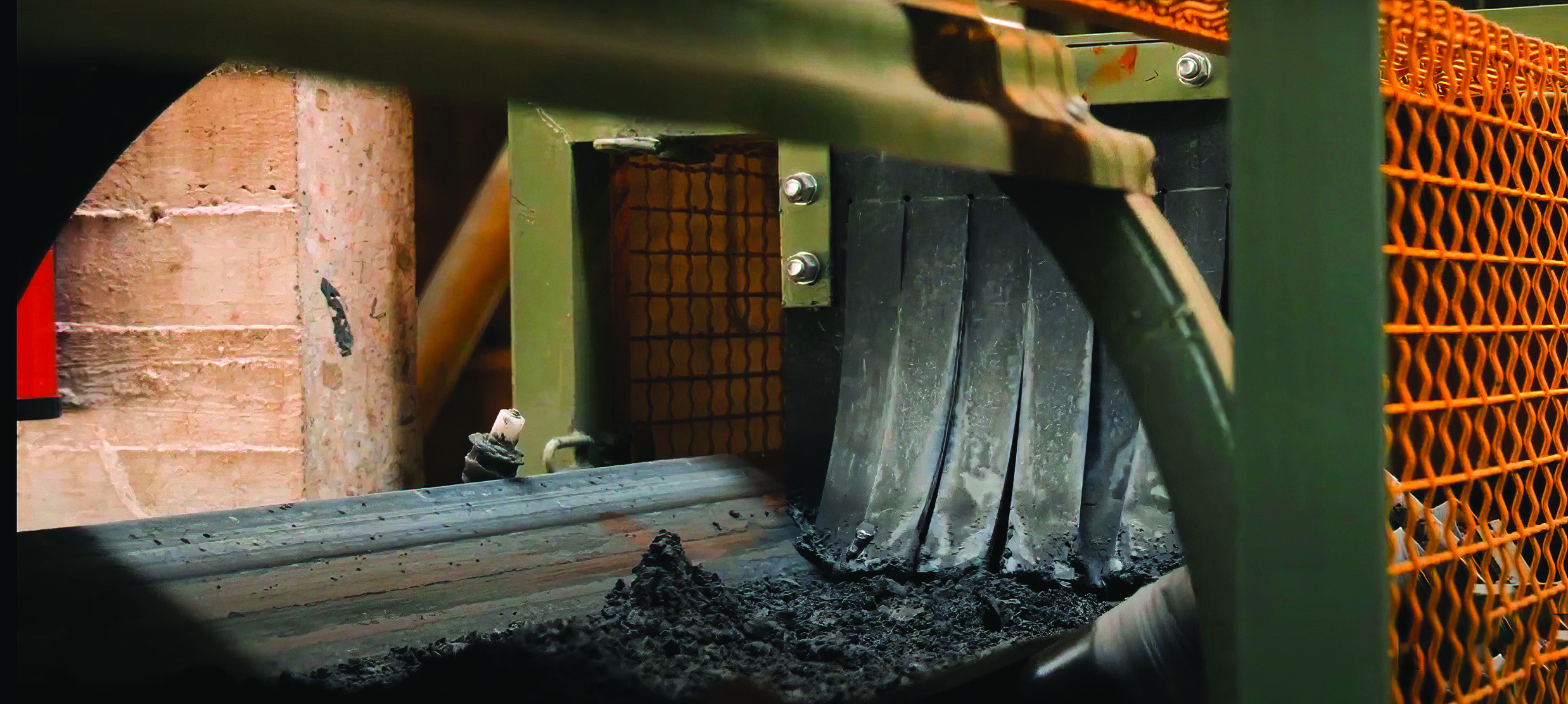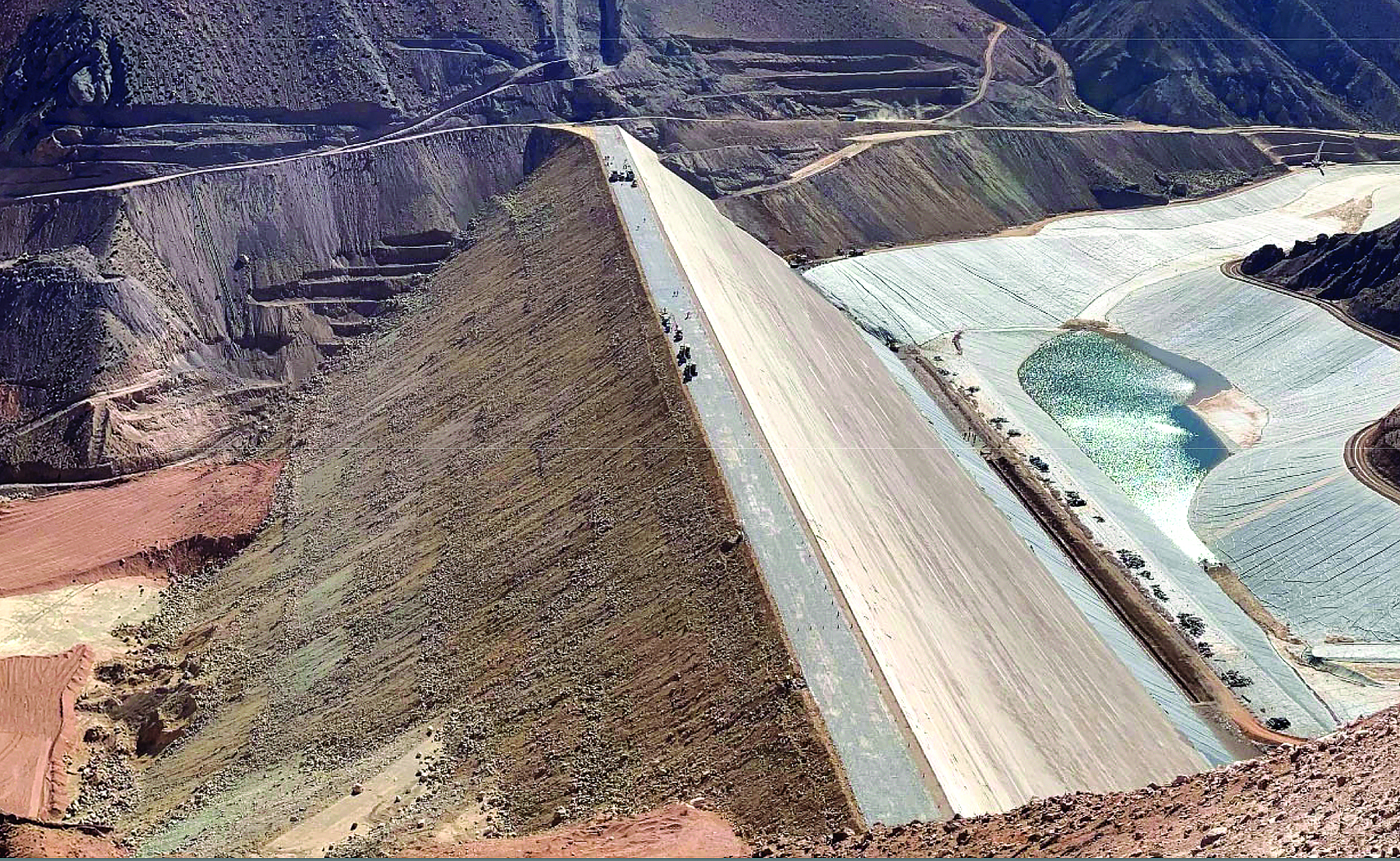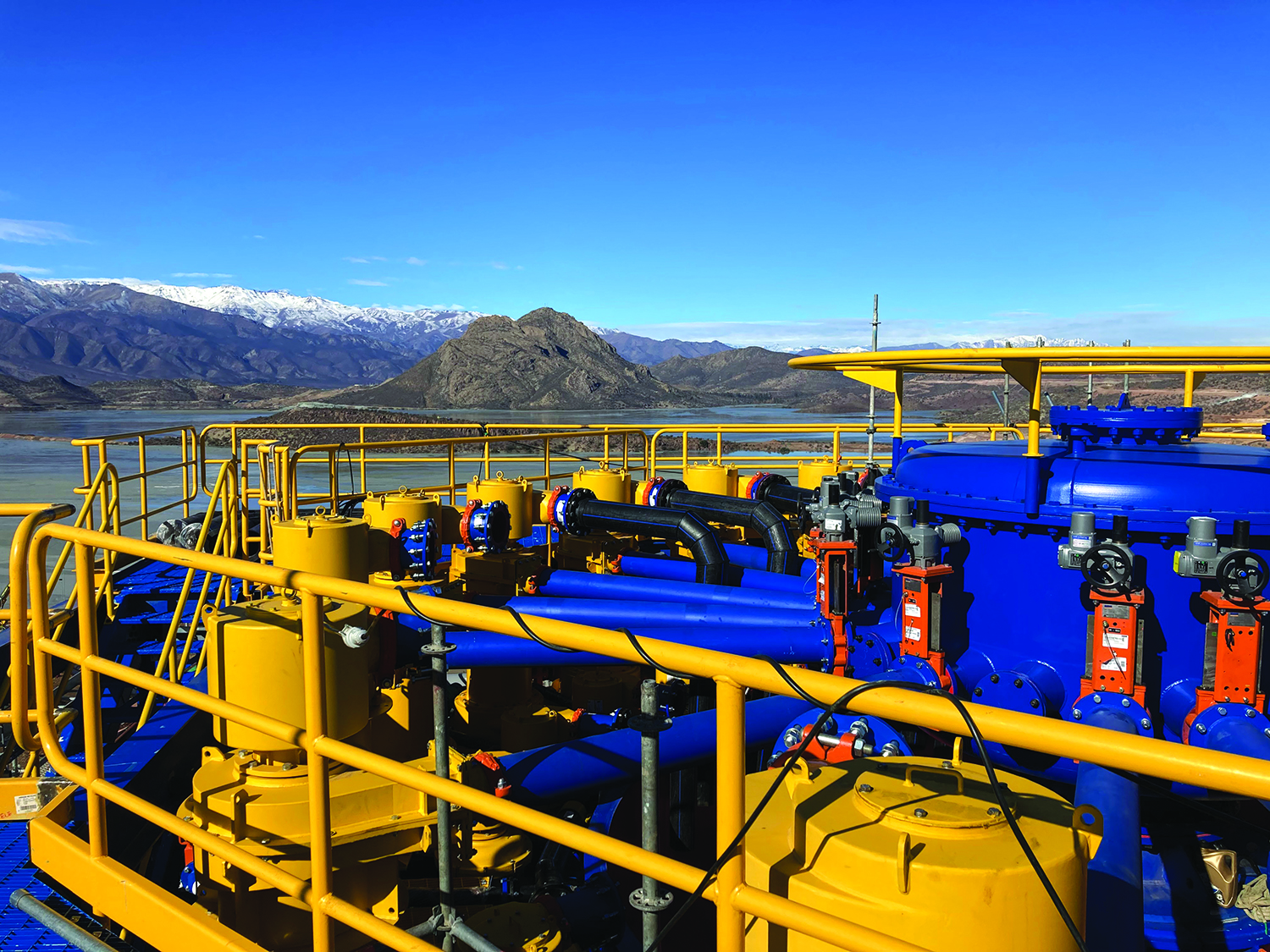
Tailings on a conveyor at an Eldorado Gold operation. The company was an early adopter of dry-stack tailings technology and currently uses the method at its mines in Turkey and Greece. (Photo: Eldorado Gold)
Producers are taking a long, hard look at traditional methods of tailings management, and finding that new operational models, emerging technologies, integrated planning and periodic reassessment can be key in meeting future challenges
By Russell A. Carter, Contributing Editor
Big numbers are important in mining. The industry depends on high levels of market demand for mineral commodities, large volumes of mine throughput, millions of tons of finished-product output and capex funding in the triple-digit billions to maintain essential profitability and growth. Right now, some of the biggest numbers it has to deal with are annual tailings production and cumulative tailings currently in impoundments – both of which are directly and indirectly linked to all of those affirmative indicators, but generally not in a positive way. Historically, tailings have been a liability for miners, and the level of that liability is rising.
The recently released Tailings Reduction Roadmap report from the International Council on Mining and Metals (ICMM) explains the situation clearly: Clean energy technologies needed to reach global climate goals will significantly increase demand for critical minerals and metals, but producers will have to process ore from lower-grade, more metallurgically complex deposits to meet that demand, and tailings production is higher in ore bodies where lower grades are mined.
“The combined tailings production rate has increased by 40% since the start of the decade with most of the tailings generation from copper and gold processing,” said the ICMM report. “Both commodities operate with some of the mining industry’s lowest ore grades, which will continue to decline into the future.”
The ICMM report warns that the global trend of increasing tailings production means tailings facilities are becoming larger and more complex, necessitating a closer look at management methods and technological practices that could be applied to address the risks associated with tailings storage. “Failure to understand and mitigate these risks can be costly, and may have severe environmental, social and financial consequences,” according to the report.

Teck reported recently that construction of the starter tailings dam at its Quebrada Blanca Phase 2 project in northern Chile was completed to design height in June. (Photo: Teck Resources)
To prove the point, the September 17 failure of the troubled Jagersfontein dam in South Africa – resulting in three fatalities, 300 injured and widespread property damage – is just the latest in a long history of tailings dam disasters that date back to the early 20th century, a period in which 257 recorded failures allowed an estimated 250 million m3 of contaminated residues to be released to the environment. Just under half (115 million m3) of that volume has been released since 2000.
Each tailings disaster washes away another layer of the relative autonomy mine operators have traditionally been granted to manage their tailings storage facility (TSF) operations, increasing exposure of the industry to demands from investors, affected communities and regulators to provide better performance, transparency and accountability in tailings management. The industry is taking steps to do that, but it’s a large, complex problem that presents issues on many levels.
For example, producers will need to reassess their historical preference for operational simplicity in tailings management against their responsibility to minimize tailings output and maintain safe TSFs. A solution needs to be developed for identifying and cataloging TSFs that have been ‘orphaned’ due to asset ownership changes or poor recordkeeping. Industry suppliers of tailings handling equipment and systems need to prove the cost-effectiveness of new technologies to an industry that’s traditionally been adverse to early adoption. Regulatory agencies need to be familiarized with new TSF design details in order to make informed decisions for permitting and inspection. C-suite executives need to be convinced there is a strong business case for potentially risking profitability to integrate new TSF approaches. And all of these issues are becoming more closely linked to the industry’s ESG commitments.
In late 2020, following an investigation launched by mining industry investors in response to the Brumadinho dam disaster in Brazil, the Mining and Tailings Safety Initiative (MTSI), a coalition of more than 100 investors with roughly $20 trillion in assets under management, called upon hundreds of companies involved in mining to publicly support and adopt the Global Industry Standard on Tailings Management (GISTM), a framework for safe management of TSFs developed jointly by the United Nations Environment Program (UNEP), Principles for Responsible Investment (PRI) and ICMM. The MTSI is led by the Church of England Pensions Board and the Swedish Council on Ethics. As of early April 2022, 45% of the mining companies contacted (65% by market capitalization) had agreed to at least review the standard and its applicability across their operations, while 50% had yet to respond, according to the initiative.
According to ICMM, all of its member companies have committed to implementation of the standard or its equivalent. ICMM concedes the standard is ambitious, pointing out that the law firm White & Case LLP had assessed its principles against nine mining jurisdictions around the world and found that in many cases the standard sets a higher threshold in terms of its comprehensiveness. It’s a challenge that is driving the industry to rethink conventional models and consider new technologies.
Tailings Tech at Teck
As an example of the industry’s direction, copper/zinc/coal producer Teck Resources has been conducting field trials at its Carmen de Andacollo operation in Chile and Highland Valley Copper mine in British Columbia, Canada, to evaluate the use of additives in tailings. At Andacollo, additives reduce the water content of the tailings discharged into the facility. This reduces the amount of water in the pond and ultimately cuts overall site water consumption. The company said that at Highland Valley, additives in the tailings discharge may allow it to both control the quality of sand dam construction and increase construction efficiency. Teck said these field trials are expected to be expanded into regular operational usage at each site.
At the company’s Quebrada Blanca Phase 2 project in northern Chile, the tailings management approach involved a design process aimed at maximizing water recovery in challenging terrain. According to Teck, it took several iterations to design a facility capable of handling 140,000 mt/d of tailings that will be transported by gravity, then separated into fine and coarse fractions. The coarse sand fraction will be used for construction of the storage embankment, while the finer fraction will be deposited into the tailings impoundment.
The tailings management facility features a 35-m-high (115-ft) rockfill cofferdam and a 120-m-high rockfill starter dam. At the end of the 25-year mine life, the tailings facility will be 310 m high. According to the company, the use of cyclone sand is a common practice in Chile and has proven to be a safe method of construction for large-scale structures such as this. Water is added to reduce the solids contents of the tailings for cycloning to produce sand for the dam construction and deposition into the TSF. The complex deposition system and tailings management maximize the reclaimed water, according to the company.
Teck also said it has expanded the use of advanced monitoring systems, including satellites, drones, autonomous robots and real-time monitoring platforms throughout its operations. It has tested new types of sensors that are able to non-intrusively and continuously monitor water levels within a tailings facility. At Andacollo, it is developing a digital tailings management platform in partnership with external vendors to improve tailings management information. When the platform is fully evaluated and implemented across the company’s asset portfolio, the digital tailings management system will enable remote monitoring of the performance of facilities.
As tailings volume from conventional processing methods increases across the industry, it’s likely to spawn more projects such as the recently-completed “world’s largest” high-rate tailings thickener, featuring a diameter of 124 m and also located in Chile. The project was a joint effort by AVA Montajes and Hatch Chile for copper miner Compañía Minera Doña Inés de Collahuasi, owned by Anglo American plc (44%), Glencore (44%) and Japan Collahuasi Resources B.V. (12%). A look at the scope of the project includes the following materials list:
• 560,000 m3 of earthworks,
• 8,500 m3 of concrete,
• 1,137 tons of rebar,
• 67,000 m2 of geosynthetics,
• 8,500 m of electrical conduit,
• 38,400 m of electrical conductors,
• 1 electrical room and 139 items of electrical equipment,
• 140 valves, and
• 9,180 m of piping.
While it’s generally accepted that big, complex problems usually involve big, often expensive solutions, the industry’s major suppliers are quick to point out that careful planning and close interaction between project owners and OEMs can lead to increased efficiency, safety and, in some cases, savings in energy and water costs associated with tailings management. In the current economic environment, many companies are looking for ways to reduce projected capital costs – possibly from improvements in TSF design – which could offset cost pressures associated with inflation and global geopolitical instability.
As we reported earlier this year (see Filtering the Flow, June 2022, pp. 46-53), filtration equipment suppliers are now offering units with much higher throughput capacity, such as Diemme Filtration’s GHT5000F Domino, a filter press with 5 x 5-m plate size that can handle as much as 12,000 mt/d or more of solids, or approximately three times the capacity of the largest filter presses currently in operation. FLSmidth is currently evaluating its MD5030 – another ultra-sized filter press featuring 5 x 3-m plate size – through pilot and prefeasibility studies with customers in need of much higher filter-unit capacity. These units, along with other high-capacity models from Andritz and Metso are aimed at supporting the mining industry’s trend toward much larger processing plants that will require filtration solutions for increased capacity, lower operating costs and easier maintenance.

Weir Minerals Cavex DE cyclone cluster at a Latin American mining operation. According to the company, DE series cyclones send 45%-55% of mass to underflow, making it 10%-15% more efficient than competing models. (Photo: Weir Minerals)
With so many variables in play at any given deposit, mine or plant that can affect the composition, stability and overall management of tailings, E&MJ spoke with a leading industry supplier to get a better understanding of commercially available solutions and options.
Charlie Stone is vice president sales and business development at Weir Minerals, which has provided custom tailings management solutions for decades and continues to partner with major mining companies in an effort to help minimize risks related to TSFs at a low total cost of ownership and reduced carbon footprint. In recent years, Weir Minerals has expanded its equipment offering, as well as signing a number of key strategic partnerships with Andritz and Eriez, to further expand its reach.
Effective tailings management has to be tailored for each site, said Stone. A multitude of factors – local climate, site topography, hydrology and physical and chemical properties of the tailings themselves, to name just a few – need to be taken into account. Risk-informed decision-making that assesses uncertainty needs to be an integral part of operators’ management strategies. And, in an increasingly tight regulatory environment, fewer greenfield projects are being approved; it is important, therefore, that OEMs work closely with mine operators to adapt and fit in with their existing operations.
Stone said Weir Minerals’ customer-centric approach is embodied in its Weir Technical Centers (WTC), located around the world. These facilities carry out advanced research and test work on behalf of its customers. Part of this work involves developing and assessing various flowsheets, with a particular focus on sustainability.
Utilizing the data generated by the WTC test loop, Weir Minerals’ specialists are able to specify tailings products and plant development to suit its customers’ site-specific environmental and operational conditions, as well as perform transient and stress analysis for pipeline installations and evaluation of materials and fittings.
While innovative flowsheet design is transforming how some miners think about and manage their tailings, the reality is that many of these recent developments could take generations to implement. Weir Minerals says it is committed to working with customers to reduce risk and provide the most effective solutions today. Here’s a rundown of common storage methods, and suitable solutions for each, offered by the company.
Untreated tailings
While untreated tailings remain the most common tailings storage method, it also poses the greatest risk. TSFs hold vast quantities of flowable tailings, and is a water-intensive practice that significantly impacts operating costs. Many operators are opting for alternative solutions that allow them to recover water and reuse it in their process. Nonetheless, it is vital that the sites that do have large quantities of untreated tailings manage their water effectively. Stone said Weir Minerals’ Warman AHP and AHPP pumps have very high-pressure capabilities that allow miners to operate several pumps in series, all consolidated into a single pump house. Additionally, Multiflo dewatering pumps can be utilized as part of the same solution for water recovery.
Thickened tailings
Thickened tailings involves the mechanical process of dewatering low-solids concentrated slurry. There are many ways to achieve this and, again, a long list of factors to consider when determining the ideal solution for each specific site and operation.
Weir Minerals’ range of Isodry thickening, filtration and centrifugation equipment spans the full spectrum of thickened tailings solutions, according to Stone, from pumpable low-solids content to high-solids applications, including dry stacking. Weir Minerals also offers its TerraFlowing solution for customers who want extremely dry tailings.
Sustainability
Paste tailings allow miners to manage their waste more sustainably, increase their water efficiency and recover value from their waste. Paste tailings reduce a mine’s environmental footprint by using significantly less water compared with liquid tailings. For example, at 60% weight solids concentration, paste requires six times less water to pump than tailings with 20% weight solids concentration. Paste tailings can then be used as mine backfill to help ensure the structural stability of the mine; this extends the Life of Mine (LOM), keeping it profitable for longer so that all the ore can be mined.
For example, the Sibanye-Stillwater PGM mine in Montana, USA is a narrow vein operation and needs to backfill stopes once they have been mined. It utilizes mill tailings as mine backfill, which are transported by custom-fit GEHO pumps that pump 1,040 l/min at 70% solids, over 425 m. These pumps are critical to their operation from a production standpoint; reliability is paramount – if a stope can’t be backfilled there is an increased risk of surface level subsidence, which could potentially halt the entire operation. But it is also important from a sustainability point of view because it is putting natural resources back underground where they originally came from, reducing the mine’s environmental footprint.
The paste used as backfill does not need to be stored on the surface. Despite these obvious advantages, there is an on-going debate within the industry around whether filtered or paste tailings are preferable from a sustainability standpoint, Stone noted.
Paste versus filtered tailings
Not all mines require backfilling. In those instances, it is often assumed that filtered tailings are the most sustainable solution because it offers a higher rate of water recovery. Weir Minerals’ Isodry filter presses can, for instance, produce products between 70%-95% dryness. For sites that experience acute water shortage, this may be the ideal solution. For sites located in wet or seasonally wet climates, where saturation of tailings is more likely to occur, paste tailings may be the preferred depositional method. There are also benefits in terms of carbon emissions because paste can be pumped, whereas filtered tailings have to be trucked, spread and compacted, all of which is fuel, power and labor intensive.
The company estimates that, when compared with the transportation of filtered tailings, its GEHO piston diaphragm pump provides up to a 20% energy saving, which equates to a 20% carbon footprint reduction. It also eliminates noise and dust pollution, which minimizes the impact on the surrounding community.
There are safety benefits associated with producing a pumpable product too. Dam failure poses the greatest risk to both the communities surrounding the mine site and the environment. Compared with diluted tailings stored in large TSFs, paste and filtered tailings present far less risk.
However, the industry has to deal with the current reality and that means ensuring the stability and integrity of existing dams to prevent any further disasters, and Weir Minerals offers equipment that can assist with the construction and maintenance of dam walls. The company says its Cavex DE hydrocyclone is the most efficient unit on the market; in comparison with a conventional hydrocyclone where 35%-40% of mass is usually sent to the underflow, Weir Minerals says the Cavex DE sends 45%-55% of mass, making it 10%-15% more efficient.
This efficiency also reduces water consumption. While the total savings will vary from site-to-site, the Cavex DE hydrocyclone can reduce water usage by up to 70% compared to conventional hydrocyclones.









